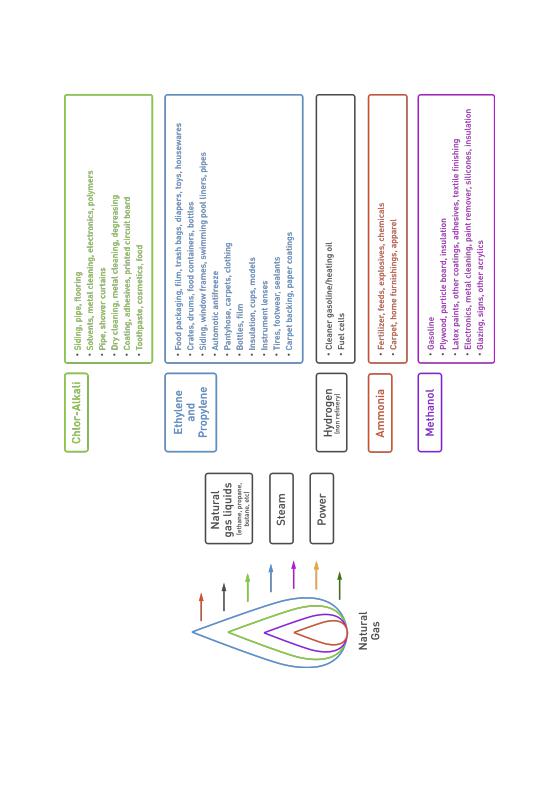
01 POWER ISLAND / 01 CCPP / DOE__Understanding Natural Gas and Lng Options October 11 2017_1
.pdf
LNG AND DOMESTIC GAS VALUE CHAINS
Domestic Gas Value Chain
The domestic gas value chain begins with production and proceeds to processing and treatment. Processing and treatment remove impurities and petroleum liquids that can be sold separately where available in commercial quantities (for petrochemicals, cooking gas, and so on.) The gas can then be compressed into a pipeline for transmission, distribution, and sale to consumers. In many countries, the gas aggregator, which is in many cases the national gas company, markets the gas to customers and operates the infrastructure.
Many national governments mandate the allocation of gas to the domestic market as this allows the development of local industries, including use as a feedstock and as fuel for power generation. Small markets will take time to develop and for the intial years of market development the most likely customers for domestic gas are power plants and existing and planned large industries.
Although supplying gas to the domestic market is an aspiration of the government, developing a commercially viable and financeable project plan based on domestic markets requires careful planning and structuring. A thorough economic analysis is required to ensure that the industry consumers are viable and the entire value chain is financially sustainable.
Hand in hand with the development of gas-fired generation, appropriate wholesale and retail market rules and institutions are a critical feature assisting in the formation of a viable domestic gas monetization plan. Unlike an LNG take-or-pay contract with one or several large customers, the integrity of the systems to collect bill payments from potentially thousands or millions of end-users in the domestic market can be a key challenge for credit risk management.
26

Domestic
Market
Introduction Domestic Uses of Gas Natural Gas Power Generation Market Structure
Interconnected Gas Markets within Sub-Saharan Africa Elements of a Gas Master Plan

DOMESTIC MARKET
Introduction
African countries have begun to develop local and regional gas markets, based in some cases on domestic pipelines, and in a few cases on regional pipelines. Markets and infrastructure remain underdeveloped and require large new investments to satisfy the needs of local populations. With welldesigned market structures, local and regional gas demand could underpin more development of natural gas resources. Market participants across Africa are expressing a preference for indigenous natural gas resources as a primary source of fuel, a feedstock for industries and chemical manufacturing, a target for foreign direct investment, and a source of foreign exchange from exports.
There is substantial potential gas demand in many parts of Africa, especially for gas-fired power generation, for fueling industry and natural gas vehicles, and LNG for transportation. A structured, well-regulated, local or regional market can be a deciding factor in how quickly gas can be developed to satisfy that demand. Although there are many challenges involved in using local and regional markets to support large gas development projects; with a suitable market structure, new technology solutions, and innovative contract models, there is likely to be an increasingly attractive range of options.
The chapters that follow review elements that can enable domestic market development and create beneficial spin-offs in terms of replacing competing fuels that can be more expensive. Some examples of local or regional infrastructure serving markets are also provided. A well-developed gas utilization master plan with adequate local participation and buy-in is normally a key component of enabling market development.
In today’s oversupplied global market for LNG, there are opportunities for supporting import projects, but also challenges for developing large-scale projects domestically.
28

DOMESTIC MARKET
Domestic Use of Gas
This section provides an overview of the potential domestic uses of natural gas. A major use for domestic natural gas is power generation. Natural gas can also be used as fuel in transportation, industries, commercial buildings or residences. Natural gas can provide fuel substitution for higher cost and more environmentally damaging fuels as well as utilizing a country's domestic resources. Additionally, natural gas can be used as a feedstock for various other industrial plants, such as fertilizer plants, methanol plants, petrochemical plants and gas-to-liquids plants.
The below diagram shows some of the domestic uses of natural gas.
29

DOMESTIC MARKET
30

DOMESTIC MARKET
Natural Gas - Fuel Supply and Demand Economics
The price of natural gas must be balanced between the cost of supply and what is affordable for consumers; otherwise, consumers will not switch to gas, assuming other alternatives are in place and/or available. The price level must be sufficient to demonstrate to the consumer adequate value that overcomes the risks and costs of converting to natural gas from the incumbent fuels (diesel, fuel oil, etc.). The fuel-switching economics must be favorable in the long term, which means, first and foremost, the price difference between the delivered cost of natural gas and the incumbent fuel must be strong over the life of investments by consumers and suppliers.
Local gas prices, particularly for imports, are influenced by global market prices and are also impacted by regulatory policy choices, which impose costs through taxes and mandated technology choices. Taxes, or the lack thereof, can provide incentives or disincentives for fuel choices. Grants, subsidies, and developing economies of scale as the adoption of new technology increases, can offset capital costs. Perhaps the greatest challenge to switching to natural gas has been the recent collapse in crude oil prices and the attendant decline in refined product prices (e.g. of distillates and heavy fuel oil).
As mentioned above, an equipment owner (power plant, ship or vehicle) must be convinced that the benefits of switching to natural gas outweigh both the next best alternative and the risks of change. Customers must be convinced that natural gas will be reliably available. Equipment suppliers, maintenance, and infrastructure must be sufficient to provide the comfort of reliability. Understanding the physical infrastructure required to meet demand is necessary to alleviate this critical concern. Consumers must also be convinced that the benefits outweigh the time and effort required to understand natural gas and its impact on operations and maintenance. Some questions that could arise are: How safe is this fuel? What happens if there is a fire? How will my operations need to change (if necessary) to accommodate this fuel? What are the costs and environmental benefits? These are all very real questions that require honest public answers.
31

DOMESTIC MARKET
Natural Gas For Power Generation
In the past, many large gas developments in Africa have focused on global gas export markets to underpin development, and domestic market opportunities have been secondary. Given the emergence of significant high-quality gas resources in many parts of Africa, the current weak demand in the global LNG market and the urgent need for new power generation facilities in many parts of the continent, the domestic gas and power value chain is becoming a much more critical feature of natural gas development.
There are challenges involved in connecting gas resource development with power demand, particularly with respect to the small size of domestic gas demand in most African countries compared to the magnitude of natural gas resources required to justify a world-scale LNG project. Nevertheless, the ability of power projects to provide the credit necessary to support financing arrangements, and to support the infrastructure required to transport gas to where the power generation is needed, means that such development remains one of the most promising opportunities to connect African gas resources with domestic markets. The use of gas for power generation is, therefore, an important policy goal, especially as power is an enabling factor to stimulate and promote other industrial development and underpin overall economic growth.
The purpose of a gas-to-power strategy is often to encourage the use of domestically produced natural gas and increase power supply to meet domestic needs for power. Imported gas is also an option, assuming either pipeline gas or LNG is available to the country. In either case domestic prices must support the cost of imported or domestically produced gas and the necessary infrastructure.. When developing a natural gas power market, the following objectives should be considered at a national level:
>Secure stable, reliable, consistent quality, and cost-effective electric
power and fuel supplies to fuel electric generation or industrial operations. Global energy price volatility and geopolitical risks will likely continue. This requires an understanding of in-country risks,
32

DOMESTIC MARKET
regional/local power grid reliability, present and future public power supply availability, local competition for power and fuel resources, public transportation systems, logistic considerations, and insourcing or outsourcing risks and opportunities to operate in an uncertain investment environment.
>Achieve sustainable cost and efficiency improvements. Understand energy-related opportunity costs at a country level. Focus on cost savings, improving domestic manufacturing and trade revenue and achieving predictable operating performance for industries through stable and affordable energy supplies.
>Collaborate internally and engage externally on energy policies and regulations, energy supplies, challenges, and opportunities.
Communication, transparency, and collaboration amongst all stakeholders are essential to managing various aspects of the natural gas power generation, transmission, and distribution project development.
>Consider the role of natural gas alongside renewable energy, energy-efficiency strategies and other clean energy technologies to address environmental concerns in addition to the utilization of hydroelectric coal, and/or oil fired base-load power. In recognizing the importance of secure, reliable and economically feasible sources of energy within baseload power generation, natrual gas for base-load power produces lower emissions, is not subject to variable rainfall issues, and provides consistent and reliable power - assuming stable gas supply is available.
>Adapt natural gas fired generation to meet the needs of local communities. Assessing the present and predicted demand and environmental concerns of communities and projects, and designing natural gas power generation or making modifications to existing facilities to meet these needs, is important to reduce emissions and increase energy efficiency. Gas- to-power measures may include power generation for industrial facilities. Gas-fired plants can also be used to run facilities for water storage, desalinization, diversion for mitigation of drought or flooding irrigation, and controlling or containing environmental releases of hazardous materials, process solutions and/or impacted water.
33

DOMESTIC MARKET
Gas to Power Implementation
Natural gas-fired power generation is based on existing and known technologies with low technology risk, repetitive and standard design, experienced engineering, procurement and construction (EPC) contractors, a global vendor market, a well-established supply chain, and flexible fuel consumption options. The result, even within Africa, is a broad selection and training environment for operators, maintenance technicians, and craft workforce. When combined with natural gas-powered vehicles or industrial, commercial and retail customers, larger scale natural gas power generation could serve as an anchor client for developing large-scale capital infrastructure for pipelines, road/rail and supporting infrastructures.
For more information on power project finance, a previous book in the Power Africa series Understanding Power Project Financing http://cldp.doc.gov/programs/cldp-in-action/details/1603.
Elements of a Gas-to-Power Value Chain
The below diagram shows a typical gas-to-power value chain in connection with an LNG export project.
This diagram assumes the gas reserves and production are offshore. The gas is piped to the shore for processing/treatment, and is then supplied to an LNG export facility. Part of the gas, after any required processing/treatment, will be transported to power plants to generate electricity. Some of the constituents of the gas, such as NGL and condensates, may be separately sold to the market. An onshore-value chain schematic would show onshore production and onshore pipeline systems.
34

DOMESTIC MARKET
Gas-to-Power Value Chain Planning
To ensure the success of a domestic gas-to-power project, proper and careful planning is required. The objective of such planning is to identify the demand centers/end-users and ensure that power can be delivered to the domestic end-users at the lowest cost while meeting reliability, safety, and environmental requirements.
For countries with an integrated electric utility company (usually owned by the government) responsible for the generation, transmission and distribution of power, the utility’s planners will conduct studies to identify the demand centers and locations for future demand growth. These are usually targeted at the main cities and other major populated areas. The electrification plan will need to address how to develop these markets in an optimized manner, and this involves the following alternatives:
>Build power plants close to the demand centers, and pipelines to deliver gas to the power plants.
>Build power plants close to where gas is available, and build transmission lines to connect to the demand centers.
The factors to be considered include:
>Cost: difference between the cost of the above alternatives is primarily the difference between the cost of pipeline vs. transmission line.
>Losses: while there are losses associated with transmitting power over long distances, transporting gas over long distances may also require added cost for intermediate compression to maintain pressure.
>Strategic considerations: the development of the initial gas-to-power project under consideration will need to fit in the overall electrification plans for the country.
>Expansion potential: whichever option is selected, the ease of expansion for additional power generation and any associated incremental pipeline/transmission investment will need to be examined.
35
